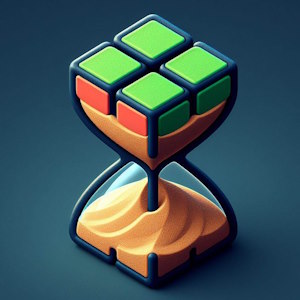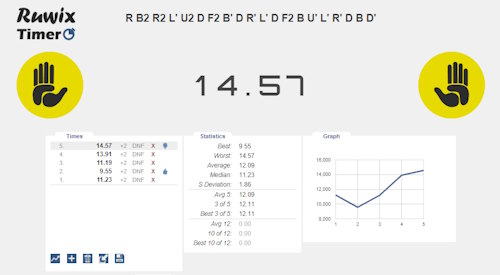Rubik Timer - Simple Rubik's Cube Stopwatch
 Press the Space bar on your keyboard or the Start/Stop button to start measuring your Rubik's Cube solution times. This simple online stopwatch will help you generate random scrambles, calculate statistics, visualize the results and many more.
Press the Space bar on your keyboard or the Start/Stop button to start measuring your Rubik's Cube solution times. This simple online stopwatch will help you generate random scrambles, calculate statistics, visualize the results and many more.
Check out the pro timer if you need more features and support for other twisty puzzles, like Megaminx, Pyraminx, Square-1, and other official competition cubes.
Rubik's Cube timers are specialized devices or software applications designed specifically for timing solves of the Rubik's Cube and other twisty puzzles. These timers play a crucial role in practicing and competing in speedcubing, where participants aim to solve the cube as quickly as possible.
Our online Rubik's Cube timer incorporates all the key features to ensure functionality, user-friendliness, and appeal to beginners and speedcubers as well. Here are some essential elements included:
-
Timer Interface: The core of the online timer is the timer interface itself. It is prominently displays the elapsed time in minutes, seconds, and milliseconds, allowing users to track their solve times accurately.
-
Start/Stop Controls: Beside the keyboard Space command a large and accessible button or controls the starting and stopping of the timer.
-
Inspection Time: An option to set an inspection time countdown before starting can be set with a dropdown from 0 to 20 seconds. This feature allows users to simulate official competition conditions, where competitors are given a limited time to inspect the cube before starting their solve.
-
Scramble Generation: Integration with a Rubik's Cube scrambling algorithm to generate random and fair scrambles for each solve. Learn more about the cube notation if you can't read the rotations.
-
Keyboard Shortcuts: Press the space button on desktop computers or tap the Start/Stop button on touch devices.
-
Offline Mode: Although the timer operates online, it requires internet connection only when you load the page. After that you can disconnect from the internet.
-
Analytics and Statistics: Advanced features such as analytics and statistics tracking can provide users with insights into their solving performance, including average solve times, best and worst solves, and improvement trends over time. Users can visualize their times on a graph
The Two Main Types of Rubik's Cube Timers:
-
Physical Timers: These are standalone electronic devices that typically consist of a timer pad and a display unit. The timer pad is a pressure-sensitive mat that records the start and stop times when the solver's hands are placed on it. An attached display unit shows the elapsed time in minutes, seconds, and milliseconds. The Stackmat timers are commonly used in official Rubik's Cube competitions organized by the World Cube Association (WCA).

-
Software Timers: Applications or websites that can be used on computers, smartphones, or tablets. They simulate the functionality of physical timers but use the device's touchscreen or keyboard as input methods. Software timers offer various features such as inspection time countdown, customizable solving sessions, and the ability to record, to analyze solve times and to generate scrambles. They are widely used by speedcubers for practice sessions and unofficial online competitions.

Rubik's Cube timers are essential tools for speedcubers to track their progress, improve their solving skills, and compete against each other.
Timing Rubik's Cube On Competitions
In official Rubik's Cube competitions organized by the World Cube Association (WCA), several steps are taken to ensure fair and accurate timing of competitors. Here's how the process typically works:
-
Scrambling: A judge scrambles the cube following the steps of a computer-generated turning sequence. This ensures that every competitor faces a similar level of difficulty in their solve.
-
Inspection: Before starting the solve, competitors are given a set amount of time (usually 15 seconds) to inspect the cube. During this time, they can look at the scrambled state of the cube and plan their solution.
-
Timing Devices: The timing device used in WCA competitions is usually a stackmat timer, known from speed stacking. This is a specialized timer connected to a pressure-sensitive pad. The competitor places their hands on the pads to start and stop the timer.
-
Judging: During the solve, a designated judge observes the competitor to ensure they follow the rules and regulations of the WCA. This includes ensuring that the competitor performs a legal scramble and solve, adhering to specific guidelines such as hand movements and cube manipulation techniques.
-
Penalties: If the competitor makes any mistakes during the solve or violates the rules, penalties may be applied. The most common example is when the competitor stops the timer with an unfinished cube or when the layers are misaligned. This can include adding time to their solve or disqualification, depending on the severity of the infraction.
-
Recording Times: The recorded time for the solve is the result after penalties (if any) have been applied. This is the time that determines the competitor's ranking in the competition.
-
Averages: In some events, competitors perform multiple solves, and their final result is calculated based on an average of these solves after dropping the best and worst times. Overall, the timing process in WCA competitions is carefully designed to ensure fairness and accuracy, allowing competitors to showcase their solving skills under standardized conditions.